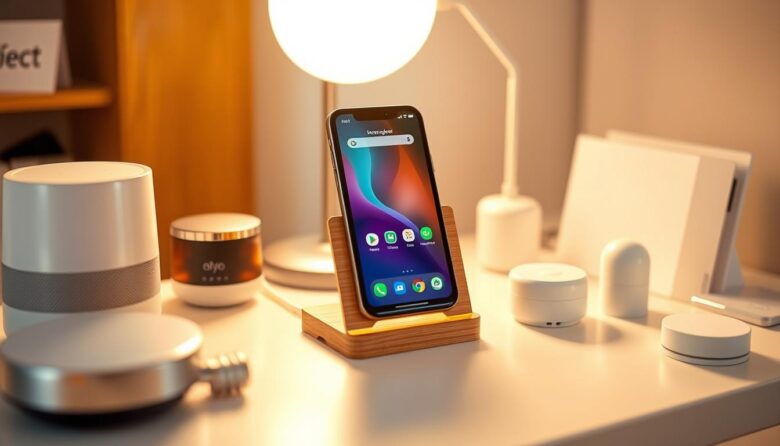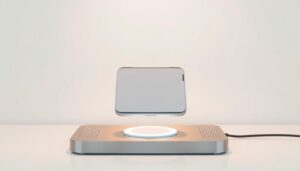Many households have unused mobile devices collecting dust in drawers. Instead of letting them go to waste, these gadgets can become powerful tools for managing modern living spaces. This guide reveals how to transform aging electronics into centralized systems for controlling lights, thermostats, and security features.
Upgrading to newer models often leaves functional hardware behind. By reconfiguring these devices, users create dedicated control centers that reduce strain on primary handsets. The process extends a product’s lifespan while supporting eco-friendly tech practices.
Simple software adjustments enable compatibility with popular platforms like Google Home or Amazon Alexa. Most setups require only basic technical skills, making the transition accessible for casual users. Centralized management improves efficiency by eliminating the need to juggle multiple apps.
Following structured methods ensures reliable performance across connected appliances. This approach offers cost savings compared to buying specialized hubs, while maintaining full functionality. Readers will learn to optimize settings, establish secure networks, and troubleshoot common issues.
Benefits of Turning Your Old Phone into a Smart Home Hub
Obsolete gadgets often retain hidden potential beyond their original purpose. Transforming retired electronics into automation tools unlocks multiple advantages for users seeking efficient, eco-conscious solutions.
Cost Savings and Practicality
Reusing existing hardware eliminates the need for pricey hub systems. Dedicated controllers from tech brands can cost hundreds, while modified devices deliver similar functionality at zero extra expense. Customizable dashboards adapt to unique household layouts and preferences.
Studies show households save up to 70% on automation setups through creative hardware reuse. Charging docks and basic mounts often complete the transformation, requiring minimal additional investment.
Reducing Electronic Waste
Over 50 million tons of e-waste accumulate globally each year. Extending a gadget’s lifecycle prevents functional components from becoming landfill pollutants. This approach supports sustainability goals while maintaining modern conveniences.
Centralized control through revived electronics reduces reliance on multiple energy-consuming appliances. Users gain an organized ecosystem that minimizes clutter and unnecessary upgrades.
Creative Ways to Repurpose Your Outdated Cell Phone
Unused mobile technology holds untapped potential beyond basic communication. Outdated devices can serve new roles through responsible redistribution or inventive modifications. This section explores ethical disposal methods and imaginative transformations that extend a phone’s value.
Ethical Disposal and Revenue Opportunities
Charitable programs like Cell Phones for Soldiers and 911 Cell Phone Bank accept functional devices. These organizations refurbish donated equipment for military families and emergency responders. Contribution drives directly support communities while keeping electronics active.
Online marketplaces offer cash returns for models with intact screens and batteries. Trade-in programs through manufacturers provide store credit for future upgrades. Recycling initiatives at electronics retailers ensure toxic materials get processed safely.
Tech-Driven Custom Projects
Modified devices become powerful tools for specific tasks. Convert retired phones into dedicated gaming consoles using emulator apps. Transform them into media servers for streaming content across household devices.
Advanced users create weather stations or air quality monitors using sensor attachments. Schools and maker spaces often use donated devices for coding workshops. Specialized applications turn cameras into wildlife observation tools or time-lapse recorders.
Repurpose Old Smartphone Smart Home Solutions
Retired mobile devices gain new purpose through specialized applications that unify household management. Powerful tools like Unified Remote convert these gadgets into universal command centers, replacing stacks of remotes with touchscreen efficiency. Users control TVs, speakers, and automated systems through streamlined interfaces accessible from any room.
Modern apps sync with leading ecosystems including Google Home and Apple HomeKit. This integration allows converted devices to adjust thermostats, lock doors, or dim lights through single-platform access. Energy monitoring dashboards and security alerts provide real-time updates without dedicated hardware.
Setup involves three simple steps: install control software, connect to Wi-Fi, and pair with smart appliances. Customizable layouts let households prioritize frequently used functions. Advanced features enable automated scenes like “Movie Night” that lower blinds and activate surround sound with one tap.
These solutions outperform basic remotes through scheduling capabilities and cross-device coordination. Touchscreen interfaces adapt to user preferences, displaying climate controls during winter or pool settings in summer. Centralized management reduces energy waste while maintaining comfort across living spaces.
Transforming Your Phone into a Home Security Hub
Retired mobile devices can serve as vigilant protectors when converted into security tools. Third-party applications unlock surveillance capabilities through simple installations, creating watchful systems that maintain property safety. These setups require only basic Wi-Fi connectivity and functional hardware to deliver professional-grade monitoring.
Setting Up as a Surveillance Camera
Specialized apps transform cameras into motion-activated sentries. Users position devices near entry points or valuables, ensuring clear sightlines and stable internet connections. Encrypted streaming lets homeowners view live feeds securely from any location.
Advanced features like night vision and activity zones enhance coverage. Cloud storage options preserve footage for later review. Automatic alerts notify users about unexpected movements, enabling quick responses to potential threats.
Using It as a Baby Monitor for Peace of Mind
Converted devices become reliable childcare assistants through monitoring software. Parents place the gadget in nurseries to receive real-time audio and video updates. Two-way communication allows comforting voices to soothe infants remotely.
Sleep analytics and temperature sensors add extra safety layers. Notifications activate when sound levels exceed normal ranges. This system eliminates costly equipment purchases while providing constant awareness of children’s well-being.
Utilizing Your Device as a Digital Photo Frame and Media Player
Dormant devices hold forgotten memories and entertainment potential waiting to be unlocked. With simple adjustments, these gadgets evolve into dynamic displays and dedicated audio systems. This transformation preserves primary phones for essential tasks while maximizing underused hardware.
Creating a Rotating Photo Display
Convert your device into an animated picture gallery using slideshow apps. Free platforms like Google Photos automatically cycle through stored images with customizable transitions. Screen optimization ensures vibrant colors and proper aspect ratios for each photograph.
Adjust brightness levels to match room lighting and prevent glare. Set timers to activate displays during specific hours, conserving energy when spaces are unoccupied. Expand storage through cloud sync features, enabling access to decades of memories without device slowdowns.
Turning It into a Dedicated Music or Podcast Player
Load your device with favorite playlists and spoken-word content for uninterrupted enjoyment. Streaming apps work seamlessly on older models when disconnected from cellular data. Bluetooth pairing with speakers creates rich soundscapes for parties or relaxation sessions.
Organize audio files into mood-based categories using playlist managers. Schedule background music during meals or workouts through automation tools. External memory cards store extensive libraries, eliminating storage conflicts with critical apps on primary devices.
Leveraging Your Phone for Remote Control and Smart Device Management
Modern households often juggle multiple controllers for their entertainment systems. A single phone or tablet can replace this clutter through specialized apps that manage TVs, speakers, and streaming devices. This approach simplifies daily routines while keeping essential tools within reach.
Controlling TVs and Entertainment Systems
Universal remote apps turn devices into powerful command centers. Popular options like AnyMote and Peel Smart Remote support infrared or Wi-Fi connections. Users program buttons for specific brands, creating custom layouts that match their setup.
These tools go beyond basic channel changes. Advanced systems let users activate “movie mode” to dim lights and launch streaming services simultaneously. Voice commands work with Google Assistant or Siri for hands-free adjustments.
Consolidating controls reduces frustration from lost remotes. Families create profiles for different members, ensuring quick access to favorite channels. The same app can manage thermostats or security cameras, creating a unified hub.
Network protocols maintain compatibility with both new and older equipment. Infrared blasters handle legacy devices, while Wi-Fi connects to modern smart TVs. This flexibility makes the system adaptable as households upgrade their tech over time.
Employing Your Phone for Navigation and Backup Communication
Reliable navigation remains essential for travelers and outdoor enthusiasts. Converted devices become powerful tools for maintaining direction and connectivity when exploring unfamiliar terrain. This approach preserves battery life on primary phones while delivering specialized functionality.
Using Offline Maps and GPS Applications
Popular apps like Google Maps and Maps.me allow users to download regional maps for offline access. These stored files guide travelers through areas with poor cellular reception. Hikers and cyclists benefit from detailed trail data that standard GPS units often lack.
Mounting a device in your car creates a dedicated navigation screen with real-time updates. Larger displays improve visibility compared to smaller primary phone screens. Constant power connections prevent battery drain during long road trips.
Backup communication becomes critical during emergencies. A secondary device with prepaid service or Wi-Fi calling ensures reliable access to emergency services. This redundancy proves valuable when primary phones malfunction or lose charge.
Specialized apps provide weather alerts and location sharing for group adventures. Many options work without internet by using Bluetooth or local networks. These features transform older models into safety tools that support confident exploration.
Budget-Friendly Strategies to Extend Your Phone’s Lifespan
Extending a mobile device’s usefulness doesn’t require expensive upgrades or replacements. Simple adjustments and mindful habits can dramatically improve performance while preserving resources. These methods help maintain essential functions for daily tasks and specialized roles.
Optimizing Existing Resources
Battery preservation starts with adjusting screen brightness and disabling unnecessary background processes. Most devices offer power-saving modes that limit energy drain without affecting core operations. These settings help maintain charge cycles longer between replacements.
Regular software updates improve efficiency by fixing bugs and closing security gaps. Clearing cached data weekly prevents storage overload that slows response times. Prioritize lightweight apps designed for older hardware to avoid processing bottlenecks.
Physical protection matters as much as digital maintenance. Affordable screen protectors and durable cases prevent costly screen repairs. Avoid exposing devices to extreme temperatures, which accelerates component wear.
Monitoring tools identify apps consuming excessive memory or power. Uninstalling unused programs frees space and reduces strain on processors. This performance tracking helps address issues before they disrupt critical functions.
Strategic use extends a device’s life through focused roles. Dedicate it to specific tasks like media playback or smart controls instead of multitasking. This approach minimizes wear while delivering consistent results for priority needs.
Understanding the Environmental Impact of Repurposing Electronics
Hidden within drawers across America, millions of devices gather dust while contributing to a growing ecological challenge. Giving these forgotten gadgets new roles combats electronic waste and reduces pressure on disposal systems. Every revived device becomes part of a sustainable cycle that benefits both households and ecosystems.
Keeping functional hardware active prevents toxic materials from leaking into soil and water supplies. This practice conserves resources by decreasing demand for rare earth metals mined through environmentally destructive processes. Manufacturing new phones generates 85% more carbon emissions than reusing existing ones.
Repurposing electronics also reduces the space needed for landfills overflowing with outdated technology. Properly redirected devices avoid becoming part of the 53 million metric tons of e-waste produced globally each year. Simple actions like wiping data and installing control apps extend a gadget’s usefulness for years.
Choosing to revitalize dormant devices demonstrates responsible tech consumption. It bridges innovation with environmental stewardship, proving convenience doesn’t require constant upgrades. Small changes in how we view “obsolete” tools create lasting impacts on planetary health.



